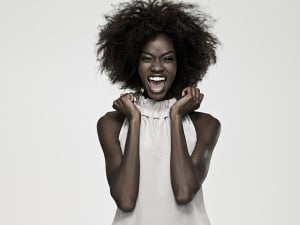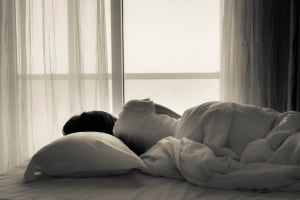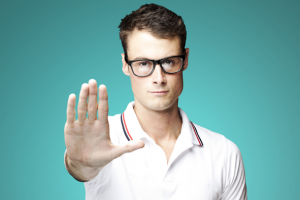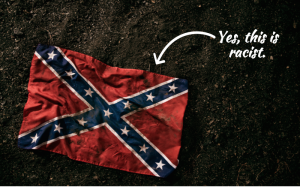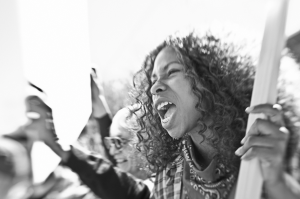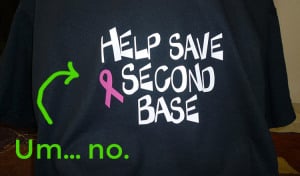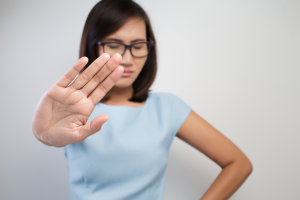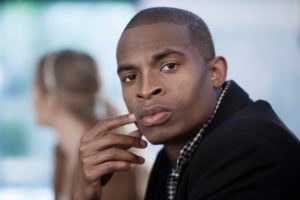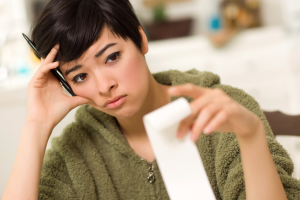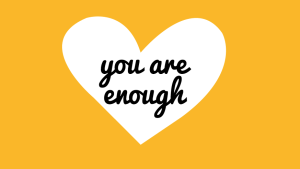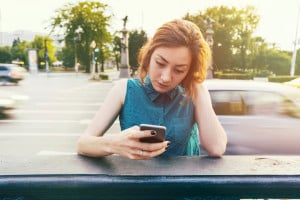
A person looking in a mirror, applying red lipstick. Source: Huffington Post
I have to cringe when I think about my early days of putting on makeup.
First, my mom wouldn’t let me touch the stuff until high school – which I can understand, knowing what I know now about how girls can be pressured to grow up too fast. But I was lagging behind other girls who’d learned to beautify their faces by middle school.
Then there was the long, awkward process of finding the right looks for me. It was discouraging to join white friends at Claire’s or flipping through dELiA*s catalogues (remember those?) and feel like I couldn’t pull off any of the looks.
I thought the pink lip glosses looked awful on me because my lips were too big, and the glittery eye shadows looked strange because my skin color was all wrong. I thought foundation was always the wrong shade because I couldn’t properly blend the two brown shades I’d found.
Too many times I cringed at my reflection and thought, “Why am I so ugly?”
I didn’t realize that this makeup wasn’t made for me at all – and neither was the ideal of beauty that I saw in magazines or the movies.
Since then, I’ve learned from my makeup blunders. But in a way, not much has changed – it’s still a challenge to find the right colors for my dark skin.
I’m sure I’m not the only one with embarrassing memories of looks I tried to pull off when I was young. These memories go even deeper than makeup – for many young girls, starting to buy beauty products goes hand in hand with learning about what beauty means.
From television shows to commercials to magazine advertisements to celebrity culture, mainstream media has a big influence on how we understand beauty in the US. It’s an impossible standard for any woman to live up to – even models themselves don’t look like their photoshopped, heavily made up images in the magazines.
The beauty industry gains a lot from convincing us that we’re too fat, or too flat chested, or we don’t have clear enough skin – anything to say we’re not good enough so we need to buy something to improve our appearance.
Though anyone can wear makeup, regardless of gender, most of these products are marketed to women. And women get very strong messages that our value depends deeply on our attractiveness.
Combine those messages with the toxic idea that only white women are beautiful (so it’s my skin color that’s wrong, not the limited selection of foundation colors), and you can understand how damaging the beauty industry is for women of color.
It’s not just skin color – we also learn that so-called “attractive” eyes, hair, noses and more rarely (if ever) appear on Latinx, Asian, Black, or Native women.
These examples show how the beauty industry says that beauty means whiteness – and why it matters.
1. The Women Who Represent ‘Beauty’ Are Almost Exclusively White
The easiest way to confirm society’s belief in whiteness as beauty is to look at the most common images presented as “beautiful women.”
Glance at a Google image search, a rack of fashion magazines, or advertisements, and it’s clear that selling the image of “beauty” usually means taking pictures of white women.
One third of the US population is Black, Native American, Asian, Pacific Islander, or Latinx – but a recent report of New York’s Fashion Week, one of the world’s biggest fashion events, revealed that participating models were 82.7% white, 9% Asian, 6% Black, and 2% Latinx.
Models of color even report that at photo shoots and runway shows, makeup artists aren’t trained or equipped to work on their skin.
South Sudanese model Nykhor Paul said it all in an Instagram post about having to bring her own makeup to set: She said that as a Black model, she’s tired of not getting booked and of having to “apologize” for her Blackness.
People in the industry just assume that creating an image of beauty means working with white women.
This has a discouraging impact on women and girls of color. Photo after photo of a standard of beauty that looks nothing like us tells us that beauty is unattainable – because we’ll never be white.
2. For Women of Color, Lighter Skin Means More Beauty
The absence of women of color in images of beauty is even more disturbing when you realize that when the industry does advertise to women of color, it often includes telling us we should have lighter skin.
This one-way colorism shows up in the beauty industry, telling women of color that the darker we are, the uglier we are.
The message is subtler when companies use light-skinned models of color or make people like Beyoncé look lighter in ads. But it can also be as blatant as selling skin lightening creams with the promise of looking prettier with lighter skin.
Many of these creams have horrible side effects, including scarring and kidney damage. They’re sold prominently in countries with high percentages of people of color – like India, where nearly two thirds of dermatological products are for skin bleaching, and Nigeria, where 77% of women use them.
Some people compare this to white women’s tanning trends to say that the grass is always greener on the other side – don’t women with pale skin want to be darker, too? The key difference is that most white people who tan aren’t doing so to look like a person of color. Some do aim for an “exotic” look, and that exotification is still harmful to people of color.
When it comes to lightening skin, the message is clearly racist: The more you can look like a white woman, the prettier you are.
3. Women of Color with More Anglicized Features Are Valued More
What do Halle Berry, Jessica Alba, and Zoe Saldana have in common?
They’re all successful actresses of color who are widely considered beautiful – and all of them have slender features and light skin.
Valuing whiteness as beauty comes down to more than just skin color. It’s also about the Anglicized features we associate with white women – smaller noses, thinner lips, less prominent curves.
We’re told that the most beautiful people in the world are celebrities like those who grace People magazine’s “Most Beautiful People” covers – and it’s no coincidence that they’re rarely women of color.
Our society bases the idea of beauty on things like the “golden ratio,” which rates traits like eye size, nose width, lip fullness, and hairstyle – and says the ideal proportions of so-called “universal beauty” never rank non-European features as most beautiful.
So the features that match the “golden ratio” are what we know as beautiful. No wonder there’s a saying that refers to the type of Black model the industry looks for: “She has to be a white girl dipped in chocolate.”
Black women everywhere are celebrating the recent visibility of actresses like Lupita Nuyong’o and Viola Davis – not only because it’s so rare for Black actresses to be so visible, but also because it’s even more rare for women with their features to be considered pretty.
One New York Times reporter revealed common ideas about Black women’s features when she called Viola “less than classically beautiful.”
Viola Davis is gorgeous – and the fact that she doesn’t look like a white woman “dipped in chocolate” doesn’t make her any less so.
4. The Straighter the Hair, The Better
I never miss an opportunity to fawn over Viola Davis – so let’s stay on the subject while we’re here.
When Davis’ character removed her wig and showed her natural hair on an episode of How to Get Away with Murder, my squeal could be heard ’round the world.
That moment was huge for Black women – because it’s so rare that a Black woman, especially a main character on primetime TV, actually gets to show her hair without wigs or flat ironing or chemical straightening.
Because naturally kinky hair is not considered beautiful.
Instead, the beauty industry shows Black women with straight hair and sells the chance to get a little closer to that unattainable beauty by chemically straightening our hair.
At the annual Victoria’s Secret runway show – widely regarded as a showcase of the most gorgeous models – Angola model Maria Borges recently made history by wearing her natural hair.
Think about that: She was the very first to show that Black women don’t have to hide their true hair texture in order to look beautiful.
This is long overdue, and it’s way past time for the rest of the industry to get on board with the beauty of Black hair.
5. The More Anglicized the Eyes, The Better
What does it mean to have beautiful eyes? According to the beauty industry, it means having eyes that look as European as possible.
East Asian women face pressure to make their eyes look “less Asian,” like the eyes many East Asian models are said to have. The pressure is so strong that some, like Chinese American media figure Julie Chen, opt for surgery to change their eyes.
Early in her career, Chen was told that her eyes looked “too Asian,” and that she would never have a seat at an anchor desk because she’s Chinese.
The Eurocentric beauty standard is so embedded in our media that it takes surgery for an East Asian woman to have a chance at success. That’s outrageous.
This standard creates common and absurd ideas about beauty, like the so-called compliment that someone is “pretty for an Asian.”
Comments like these show that people actually believe that beauty is a white thing – and pretty people of color are just rare exceptions to the rule.
6. Light Eyes Are Considered Prettier Than Dark Ones
It’s not just the shape of the eyes that matter for the mainstream media’s idea of beauty. Color matters, too – and with colors like blue and green so often considered to be most beautiful, ethnic groups that tend to have darker eyes are once again excluded.
We don’t typically associate dark skin with light colored eyes. So between selling colored contact lenses and fawning over women of color with naturally light eyes, eye color is another way for companies to say that women of color have to pursue whiteness to attain beauty.
It’s another aspect of the “white girl dipped in chocolate” appeal.
It also plays into the “exotic” woman of color trope. This trope upholds racism by othering women of color, and also with the implication that a woman of color who “looks” like her ethnicity isn’t attractive.
But a woman of color who has features that aren’t typically associated with her ethnicity is said to be more beautiful – implicitly – because she’s closer to being white.
7. The Selection of Products Available for Women of Color Is Limited
I’d really rather not revisit my awkward teenage years again, but let’s talk about that for the briefest of moments.
I mean, I was a young teenager, and it was the late 90s, so a certain level of awkwardness in appearance is to be expected. But I had no idea I’d have to face such a stark lack of beauty products for me to use – and that I’d still struggle to find them even as an adult.
Dark-skinned women who use foundation, for example, are familiar with this scenario: Rows and rows of colors to match the various shades of fair skin, and no more than two or three for brown skin – none of which are your shade.
I never enter giveaways for beauty products, because I can safely assume that what’s presented as a “one size fits all” package of hair, skin, and makeup supplies is actually only for white women.
Oftentimes, the available selection looks like we don’t even exist. We have to create our own products or companies, and racism in the industry can make those impossible to get off the ground.
I swear I’m not just complaining for the sake of my own beauty regiment, though it feels good to get that off my chest. When you think about this lack of selection in combination with the products for women of color that I have mentioned so far – things like hair straighteners and skin lightening creams – you get a disturbing picture.
To the beauty industry, women of color aren’t worth having products meant to celebrate our natural beauty. But we do have value as consumers paying into a multi-billion dollar industry of changing ourselves to look more like white women.
8. The Same Looks That Are Criticized on Women of Color Are Praised on White Women
Nothing tells the story of double standards in beauty like cultural appropriation.
From headdresses to moccasins, dreadlocks to cornrows, bindis to saris – every group of people of color has a long history of cultural traditions that we’ve had to fight to maintain through colonization, racism, and genocide.
In terms of beauty standards, this looks like being told that your culture’s traditional styles make you look anything from “ugly” to “too ethnic” to “dangerous.”
Like the Black eighth grader who was recently ejected from class and told her “poofy” hair looked “unprofessional,” for instance. I feel for that girl and so many like her who have bullies, school administrators, and the media telling them that the way their hair grows naturally is unappealing.
And I rage for them when I then see magazines praising white women in cornrows, dreadlocks, and even afros as “edgy,” “trendy,” and “epic.”
These are just a few of the many examples of women of color being ostracized for the same looks that white women are said to innovate and make “beautiful.”
This double standard just piles on to the message that a look is only pretty if a white woman is wearing it.
9. Companies Use Casual Racism to Sell Their Products
As if excluding women of color from images of beauty wasn’t bad enough, many of these companies add insult to injury by blatantly putting women of color down with racism in their marketing.
Dove, Benefit, Illamasqua – the list of companies with racist marketing campaigns could go on and on. Sometimes, enough people speak up about it and public pressure leads these companies to apologize and make a change.
But racist incidents happen so often, in an industry so centered on whiteness, that the defense that these are all innocent mistakes is unconvincing. And regardless of marketers’ intentions, the harmful impact of what they’ve done is a huge problem.
Take the MAC Cosmetics collection that referenced Juarez, the Mexican border town facing a human rights crisis with horrendous numbers of women and girls being murdered.
MAC apologized and promised to donate proceeds to human rights groups working in Juarez. At best, Mexican women are so invisible in their minds that it didn’t occur to the MAC team that exploiting their suffering for profit would hurt real human beings.
At worst, Mexican women are so unimportant to them that they just didn’t care until they realized the outrage might hurt their image.
Either way, these incidents show that women of color simply don’t matter to the beauty industry.
10. Models and Other People in the Industry Who Speak Out Against Racism Get Penalized
To solve this problem, we have to figure out what’s in the way of eradicating a Eurocentric standard of beauty – and if you look into it, you’ll find some very deliberate obstacles in the way.
People in the industry risk losing their careers if they talk about it.
Models like Naomi Campbell, Iman, and Tyson Beckford have reached a superstar status that’s rare for models of color – and they’ve all spoken out about the awful racism they’ve had to deal with along the way.
In 2007, after decades of dealing with it, Campbell came together with other Black models to pressure the industry to address its racism. Bethann Hardison, who modeled in the 1970s and started her own agency that helped launch the careers of Campbell and Beckford, organized the action.
These examples show that it takes achieving superstar status and building strong alliances to be able to talk about these issues without losing your career. For lesser known models, it’s often too risky, as Iman found when she tried to recruit Black models to make a statement with a cover line “Black girls rule” and had a hard time persuading them to participate.
As Nykhor Paul pointed out in her post on her experiences as a Black model, talking about this issue puts a model at risk for being labeled “the angry Black girl” and getting blacklisted from jobs.
When the people who speak out are treated this way, you have to wonder how many more have stories of outrageous racism and are afraid to talk about it.
And you have to realize it’s going to take all of us to demand a change.
***
Of course, true beauty is subjective and we’re all beautiful in our own ways. We don’t have to rely on a racist beauty industry to recognize our beauty.
But it’s difficult to feel beautiful when the industry has so much power in setting society’s standard for what beauty means.
Not to mention that the concept of beauty itself holds so much power – for women and girls, our self-worth is tied to our appearance everywhere we turn.
For women of color, the Western, Eurocentric standard of beauty creates internalized self-hatred. We’re told that striving for beauty isn’t just a matter of presenting our best self, but of fundamentally changing ourselves with things like hair straightening chemicals, plastic surgery, and toxic skin-lightening creams.
Lupita Nyong’o talked about feeling this impact, saying, “I remember a time when I, too, felt unbeautiful. I put on the TV and only saw pale skin. I got teased and taunted about my night-shaded skin. And my own prayer to God, the miracle worker, was that I would wake up lighter-skinned.”
I can relate, and so can countless other girls and women of color hoping for the same miracle – and for smaller noses, bigger eyes, smaller lips. They don’t know the truth: that they’re already miracles of beauty, proving the beauty industry’s hideous racism wrong with their radiance.
[do_widget id=’text-101′]
Maisha Z. Johnson is the Digital Content Associate and Staff Writer of Everyday Feminism. You can find her writing at the intersections and shamelessly indulging in her obsession with pop culture around the web. Maisha’s past work includes Community United Against Violence (CUAV), the nation’s oldest LGBTQ anti-violence organization, and Fired Up!, a program of California Coalition for Women Prisoners. Through her own project, Inkblot Arts, Maisha taps into the creative arts and digital media to amplify the voices of those often silenced. Like her on Facebook or follow her on Twitter @mzjwords.
Search our 3000+ articles!
Read our articles about:
Our online racial justice training
Used by hundreds of universities, non-profits, and businesses.
Click to learn more





